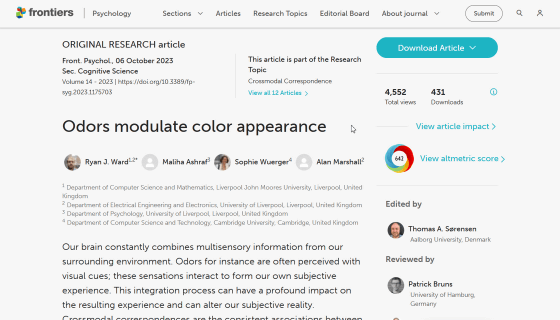Experiments reveal that the ``smell you smell'' can even affect color perception

Humans unconsciously combine multiple senses, and some people have actually experienced things like ``I can smell the orange flavor from an orange drink,'' and ``I associate warm colors such as red and orange because of the warmth.'' Should be. The mutual influence of multiple perceptions in this way is called
Frontiers | Odors modulate color appearance
https://www.frontiersin.org/articles/10.3389/fpsyg.2023.1175703/full

Research reveals how smell can influence our perception of color - Articles - School of Life Sciences - University of Liverpool
https://www.liverpool.ac.uk/life-sciences/news/articles/research-reveals-how-smell-can-influence-our-perception-of-colour
Our sense of smell changes the colors we see, show scientists - Science & research news | Frontiers
https://blog.frontiersin.org/2023/10/06/frontiers-psychology-cross-modulation-sense-of-smell-color-vision/
What You Smell Can Change The Way You Perceive Color : ScienceAlert
https://www.sciencealert.com/what-you-smell-can-change-the-way-you-perceive-color
Human senses such as smell, taste, sight, hearing, and touch are not completely independent, and in fact, there is a certain degree of ``crossover'' between the senses. In past research , subjects were shown a dot moving across a computer screen while smelling a particular odor, and the researchers investigated how fast they perceived the dot to be moving. As a result, it was found that subjects who smelled the ``lemon scent'' saw the dots appear to move more slowly, and conversely, when they smelled the ``vanilla scent,'' the dots appeared to move faster.
In addition, a study conducted in 2021 by Liang Ward, a senior lecturer at Liverpool John Moores University in the UK, and others found that ``caramel scent'' is associated with dark brown and yellow, and ``coffee aroma'' is associated with dark brown. It was shown that red, ``cherry scent'' are associated with pink, red, and purple, ``peppermint scent'' is associated with green and blue, and ``lemon scent'' is associated with yellow, green, and pink.
This time, Ward and his team conducted a new experiment to investigate the influence of the human sense of smell on color perception. The experiment involved 24 men and women between the ages of 20 and 57 who did not wear deodorant or perfume and had no impairments in color vision or smell.
The subjects sat in front of a screen in an isolated room with no unnecessary sensory stimulation, and after being deodorized with an air purifier for 4 minutes, they were randomly selected from ``caramel, coffee, cherry, peppermint, lemon, and odorless.'' The scent was released into the room using an ultrasonic diffuser.

A randomly colored square was then displayed on a computer screen, and subjects were given the task of moving a slider to adjust the color of this square until it was a neutral gray. There were two sliders, one that changed from ``yellow to blue'' and one that changed from ``green to red,'' and the subjects moved each slider while smelling the odor and returned the square to gray. In addition, the subjects were not informed that ``a specific odor will be emitted'', but were simply told to perform the task on the computer screen.
As a result of the experiment, it was found that the subject's color perception was influenced by the ``smell he was smelling at the time.'' Participants who smelled four of the five scents, excluding peppermint, were more likely to produce a gray color that was biased toward the color associated with that scent.
For example, when subjects smelled coffee, they were more likely to perceive a reddish-brown gray as a neutral gray, and when they smelled caramel, they were more likely to perceive a yellowish gray as a neutral gray. I am.
Ward said, ``Our experiments showed that the perception of gray tends to be biased toward the expected cross-modal correspondence for the aromas of lemon, caramel, cherry, and coffee.This ``overcompensation'' is due to 'This suggests that the role of cross-modal associations in processing sensory input is strong enough to influence the perception of information from different senses (in this case, odor and color).'

Related Posts:
in Science, Posted by log1h_ik






